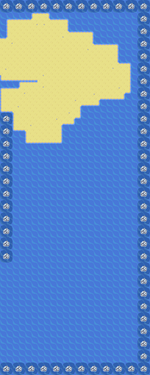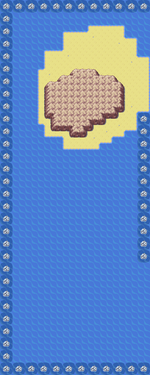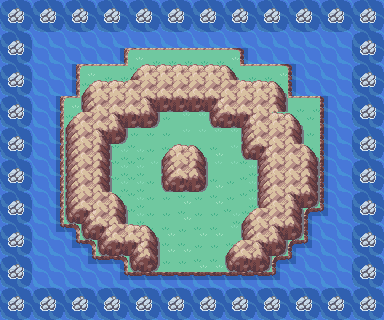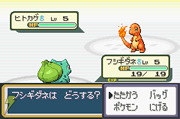Pokémon FireRed and LeafGreen beta: Difference between revisions
| Line 27: | Line 27: | ||
* Sevii Isle 24 (Japanese: 24ばん ななしま ''Nanashima 24'') | * Sevii Isle 24 (Japanese: 24ばん ななしま ''Nanashima 24'') | ||
Sevii Isles 6 and 7 have map data consisting of only a single tile. Sevii Isle 6 has a tile that can be surfed on, while Sevii Isle 7 has only a tile cannot be walked or surfed on. Sevii Isles 8 and 9 have fully programmed map data, implying that they were scrapped very late during development. The music theme that plays on all four is ナナシマ ''[[Pokémon FireRed & Pokémon LeafGreen: Super Music Collection|Sevii Islands]]'' if the {{player}} enters them by land. | Sevii Isles 6 and 7 have map data consisting of only a single tile. Sevii Isle 6 has a tile that can be surfed on, while Sevii Isle 7 has only a tile tha cannot be walked or surfed on. Sevii Isles 8 and 9 have fully programmed map data, implying that they were scrapped very late during development. The music theme that plays on all four is ナナシマ ''[[Pokémon FireRed & Pokémon LeafGreen: Super Music Collection|Sevii Islands]]'' if the {{player}} enters them by land. | ||
If the [[Town Map]] is opened at Sevii Isles 6, 7, 8, or 9, it displays the player's location as if they were near {{OBP|Four Island|town}}. Additionally, their index numbers are located after [[Three Isle Port]] and before [[Resort Gorgeous]]. This may mean that they were originally routes on [[Four Island]]. | If the [[Town Map]] is opened at Sevii Isles 6, 7, 8, or 9, it displays the player's location as if they were near {{OBP|Four Island|town}}. Additionally, their index numbers are located after [[Three Isle Port]] and before [[Resort Gorgeous]]. This may mean that they were originally routes on [[Four Island]]. | ||
Revision as of 02:16, 25 September 2017

|
This article is incomplete. Please feel free to edit this article to add missing information and complete it. |
Pokémon FireRed and LeafGreen, as remakes of Pokémon Red and Green, implemented redone elements of the original games. Nonetheless, as individual games, they have gone through similar stages of development as all the other core series games.
Pre-release
Early sprites for Bulbasaur and Charmander were seen in a pre-release screenshot published by Dengeki Online.[1]
A different sprite for Professor Oak that would have been used in the New Game tutorial of the games was seen in a Japanese commercial. This commercial also shows the color-based text distinction for male and female NPCs that the localizations would adopt, which was not used in the Japanese versions (instead, they use two fonts to make the distinction).
| |
Post-release
Locations
Sevii Isles
More routes were planned for the Sevii Islands. However, each one of these routes that are still programmed in on Pokémon FireRed and LeafGreen is called Sevii Isle (Japanese: ななしま Nanashima), suggesting that they are islands instead of routes. Their Japanese name is shared with that of the Sevii Islands, with the only difference being that the Sevii Isles use hiragana as opposed to the Sevii Islands' usage of katakana.
Counting from the "first" route in the Sevii Islands, Kindle Road, and going down numbers the Sevii Island routes into the same order reflected by the Sevii Isles, suggesting that the routes of the Sevii Islands were originally intended to be numbered in this way.
The location name data programmed in for the Sevii Isles is:
- Sevii Isle 6 (Japanese: 6ばん ななしま Nanashima 6)
- Sevii Isle 7 (Japanese: 7ばん ななしま Nanashima 7)
- Sevii Isle 8 (Japanese: 8ばん ななしま Nanashima 8)
- Sevii Isle 9 (Japanese: 9ばん ななしま Nanashima 9)
- Sevii Isle 22 (Japanese: 22ばん ななしま Nanashima 22)
- Sevii Isle 23 (Japanese: 23ばん ななしま Nanashima 23)
- Sevii Isle 24 (Japanese: 24ばん ななしま Nanashima 24)
Sevii Isles 6 and 7 have map data consisting of only a single tile. Sevii Isle 6 has a tile that can be surfed on, while Sevii Isle 7 has only a tile tha cannot be walked or surfed on. Sevii Isles 8 and 9 have fully programmed map data, implying that they were scrapped very late during development. The music theme that plays on all four is ナナシマ Sevii Islands if the player enters them by land.
If the Town Map is opened at Sevii Isles 6, 7, 8, or 9, it displays the player's location as if they were near Four Island. Additionally, their index numbers are located after Three Isle Port and before Resort Gorgeous. This may mean that they were originally routes on Four Island.
No wild Pokémon are programmed into these areas by default. No index pointers lead to them by default either; on Sevii Isle 8, the central island on the route has what one would assume to have been cave entrances changed into the side of a rock.
Sevii Isles 22, 23, and 24 have their location name data placed between the Tanoby Ruins and Navel Rock. If a map is given the header of Sevii Isle 22, 23, or 24, the player's location will display as if they were near the Tanoby Ruins. Additionally, the unused maps with pointers $0033560C, $00336170, and $00337814 in the English version ($0033560C, $00336170, and $00337814 in the Japanese version) are stored immediately after the Tanoby Ruins as well, which may mean that those maps were originally intended for use as Sevii Isles 22, 23, and 24.
Sevii Isle 6 in the Town Map
Sevii Isle 7 in the Town Map
Sevii Isle 8 in the Town Map
Sevii Isle 9 in the Town Map
Sevii Isle 22 in the Town Map
Sevii Isle 23 in the Town Map
Sevii Isle 24 in the Town Map
Other locations
The following maps are also unused:
- Record Corner
- a house interior found in the data of Routes 6, 19, and 23 with no events or warps
- duplicates of Celadon Hotel and restaurant
- the copy for the main room without boxes blocking access to the second room and the second room itself of the Mystery Trainer house in Seven Island (the e-Reader cards for use with Mystery Gift in Japanese versions are for the Trainer Tower)
Leftover copies from Pokémon Ruby and Sapphire of certain Hoenn locations using broken tilesets are also present in the ROM.
Hoenn's Safari Zone Area 1
Hoenn's Safari Zone Area 2
Hoenn's Safari Zone Area 4
- Unused Hoenn Batttle Tower FRLG.png
S.S. Tidal's hall
S.S. Tidal's basement
S.S. Tidal's cabins
The maps below appear to be related to other maps.
| Map | Notes |
|---|---|

|
Japanese map offset: $002F96BC English map offset: $0033560C Looks similar to Sevii Isle 9. Possibly Sevii Isle 22. The exits have the same dimensions as the exits of the map with offset $002FA220 (Japanese ROM) or $00336170 (English ROM). |

|
Japanese map offset: $002FA220 English map offset: $00336170 Looks similar to Sevii Isle 8. Possibly Sevii Isle 23. The map has the same dimensions as the Tanoby Ruins. |

|
Japanese map offset: $002FB8C4 English map offset: $00337814 Looks similar to Sevii Isle 9. Possibly Sevii Isle 24. The exits have the same dimensions as the exits of the map with offset $002FA220 (Japanese ROM) or $00336170 (English ROM). |

|
Japanese map offset: $002FC428 English map offset: $00338378 Appears to be an earlier version of the area where Trainer Tower is located at on Seven Island. |
Items
Key Items exclusive to Pokémon Ruby and Sapphire (and also Pokémon Emerald) are found within the internal data, complete with item sprites and Bag descriptions that differ from those of Ruby and Sapphire, due to their different layout and menu setup, which allows less space for the descriptions. These items are only obtainable by cheating or modification of the saved game data. For the most part, they have no use, though the Mach Bike and Acro Bike will act the same as the normal Bicycle obtainable in FireRed and LeafGreen with the exception of not being recognized by the games for entering Cycling Road.
HM08, unobtainable except by cheating and containing Dive like in Ruby, Sapphire, and Emerald, can be taught and deleted freely, making its use almost the same as a normal TM.
Music
Audio track with index number 0x0119 in the ROM plays an unused version of Pokémon Healed which is a chiptune-like rearrangement of the regular theme used by the games, and that also resembles the original theme from Pokémon Red and Green. This may hint at a planned earlier implementation of a feature like GB Sounds.
Sprites
Unused overworld sprites of Mew, Raikou, Entei, Suicune, Celebi, and Deoxys's Attack and Defense Formes have also been discovered in the internal data. Their use is not known but it is possible that they might have been planned for events. Many of the trainer class sprites were carried over from Pokémon Ruby and Sapphire but go unused as well.
| Unused Mew overworld sprite | Unused Raikou overworld sprite | Unused Entei overworld sprite | Unused Suicune overworld sprite | Unused Celebi overworld sprite | Unused Deoxys Attack Forme overworld sprite | Unused Deoxys Defense Forme overworld sprite |
Weather
The overworld weather effects are carried over from Pokémon Ruby and Sapphire but only a few are used. Like its predecessors, Pokémon FireRed and LeafGreen don't use the "four snowflakes falling" effect.
References

|
This game-related article is part of Project Games, a Bulbapedia project that aims to write comprehensive articles on the Pokémon games. |




















